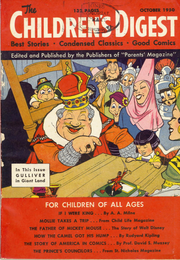
Children's Digest
Encyclopedia

Jack and Jill (magazine)
Jack and Jill is a bimonthly American magazine for children 7 to 10 years old which takes its title from the nursery rhyme of the same name. It features stories and educational activities....
from the same publisher. For over 20 years it was published in the digest size
Digest size
Digest size is a magazine size, smaller than a conventional or "journal size" magazine but larger than a standard paperback book, approximately 5½ x 8¼ inches, but can also be 5⅜ x 8⅜ inches and 5½ x 7½ inches. These sizes have evolved from the printing press operation end...
implied by its name, but it subsequently switched to a larger format more similar to other magazines. Humpty Dumpty Magazine
Humpty Dumpty Magazine
Humpty Dumpty is an American magazine for children 5 to 7 years old which takes its title from the nursery rhyme of the same name. It features stories and educational activities....
is a sister publication of similar format aimed at a younger audience, which continues in publication.
Its original concept was similar to that of Reader's Digest
Reader's Digest
Reader's Digest is a general interest family magazine, published ten times annually. Formerly based in Chappaqua, New York, its headquarters is now in New York City. It was founded in 1922, by DeWitt Wallace and Lila Bell Wallace...
, but aimed at children. The publisher stated in the first issue that "Just as the Reader's Digest reprints the best from adult magazines and books, so The Children's Digest will reprint the best stories, comics, and other features from children's magazines and books published throughout the world." Content included fictional stories, non-fiction articles, puzzles, and comics, mostly reprinted or adapted from other publications but occasionally original to Children's Digest. Articles were sometimes by well-known authors such as Isaac Asimov
Isaac Asimov
Isaac Asimov was an American author and professor of biochemistry at Boston University, best known for his works of science fiction and for his popular science books. Asimov was one of the most prolific writers of all time, having written or edited more than 500 books and an estimated 90,000...
, and covered subjects ranging from science to celebrities and sports stars of current interest. (Joe Namath
Joe Namath
Joseph William "Joe" Namath , nicknamed "Broadway Joe" or "Joe Willie", is a former American football quarterback. He played college football for the University of Alabama under coach Paul "Bear" Bryant and his assistant, Howard Schnellenberger, from 1962–1964, and professional football in the...
was cover-featured in a 1969 issue, and Lew Alcindor, later known as Kareem Abdul-Jabbar
Kareem Abdul-Jabbar
Kareem Abdul-Jabbar is a retired American professional basketball player. He is the NBA's all-time leading scorer, with 38,387 points. During his career with the NBA's Milwaukee Bucks and Los Angeles Lakers from 1969 to 1989, Abdul-Jabbar won six NBA championships and a record six regular season...
, also appeared on a cover.) Classic stories from such authors as Rudyard Kipling
Rudyard Kipling
Joseph Rudyard Kipling was an English poet, short-story writer, and novelist chiefly remembered for his celebration of British imperialism, tales and poems of British soldiers in India, and his tales for children. Kipling received the 1907 Nobel Prize for Literature...
and Hans Christian Andersen
Hans Christian Andersen
Hans Christian Andersen was a Danish author, fairy tale writer, and poet noted for his children's stories. These include "The Steadfast Tin Soldier," "The Snow Queen," "The Little Mermaid," "Thumbelina," "The Little Match Girl," and "The Ugly Duckling."...
were often printed. Comics reprinted in Children's Digest included from 1966 to 1979 monthly installments of The Adventures of Tintin
The Adventures of Tintin
The Adventures of Tintin is a series of classic comic books created by Belgian artist , who wrote under the pen name of Hergé...
. These serializations greatly increased Tintin’s popularity in the United States. At this time Children's Digest had a circulation of around 700,000 copies monthly.
For a long time, the paper was given a light greenish tint which was referred to as "eye-ease" tinted paper; the publishers claimed that scientific tests proved it to be easier on the reader's eyes.
Children's Digest was originally owned by the publishers of Parents
Parents (magazine)
Parents, published by Meredith Corporation, is the oldest parenting publication in the U.S. It was first published in October 1926.Its editorial focus is on the daily needs and concerns of mothers with young children. The glossy monthly features information about child health, safety, behavior,...
magazine, but was sold to The Saturday Evening Post
The Saturday Evening Post
The Saturday Evening Post is a bimonthly American magazine. It was published weekly under this title from 1897 until 1969, and quarterly and then bimonthly from 1971.-History:...
Society in the early 1980s. It had a special focus on health and well-being for children. It was aimed at children of ages 10 through 12.

